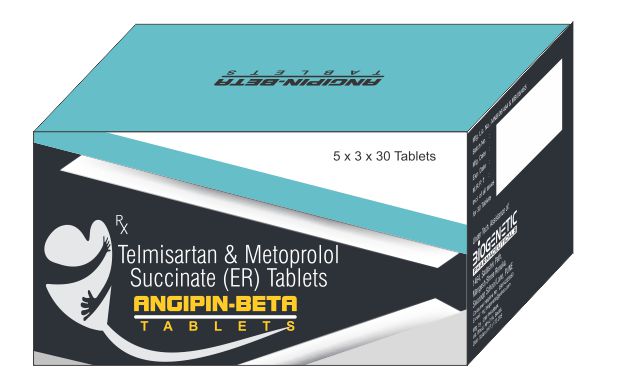IndicationsTelmisartan and Metoprolol Succinate is used in the treatment of HYPERTENSION also known as HIGH BLOOD PRESSURE. It is a long-acting angiotensin receptor blocker (ARB), which is having multiple positive effects apart from its antihypertensive efficacy. These drugs are the cardioprotective drugs, combination of telmisartan and metoprolol is beneficial for secondary prevention of cardiovascular events in high-risk patients with HT.
Mechanism of ActionThis is the combination of two blood-pressure lowering medicines: Telmisartan and Metoprolol Succinate. Telmisartan is an angiotensin receptor blocker (ARB). It works by blocking the chemical angiotensin and then blood vessels get relaxed . Metoprolol Succinate is a beta blocker which works on the heart to reduce heart rate and which lowers the blood pressure. Together they allow the blood to flow more smoothly and the heart to pump more efficiently.
Pharmacokinetics
Metoprolol:
Metoprolol has short halflife of 3 to 7 hours ,so it should be taken atleast twice daily or as a slow release preparation.It undergoes α-hydroxylation and O-demethylation as a substrate of the cytochrome liver enzyme and a small percentage by CYP3A4, resulting in inactive metabolites.
Telmisarton:
Absorption of telmisartan is rapid although the amount absorbed varies. The absolute bioavailability for telmisartan is about 50%.When it is taken with food, the reduction in the area under the plasma concentration-time curve of telmisartan varies from approximately 6% or about 40 mg dose to approx. 19% or about 160 mg dose.
Distribution - It is largely bound to plasma protein mainly albumin and alpha-1 acid glycoprotein. The mean steady state apparent volume of distribution is approx 500 l.
Metabolism- It is minimally metabolized by conjugation to form a pharmacologically inactive acylglucuronide. The cytochrome P450 isoenzymes are not involved in the metabolism of telmisartan.
Elimination-After oralor intravenous administration telmisartan is nearly exclusively excreted with the feces, as unchanged compound. Cumulative urinary excretion is < 1% of dose. Therefore total plasma clearance is high approx 1,000 ml/min compared with hepatic blood flow about 1,500 ml/min.
Side Effects
● Headache
● Weakness
● Dizziness
● Cold extremities
● Slow heart rate
● Increased potassium level in blood
● Numbness of extremity
● Decreased blood pressure
Contraindications
● This product may increase potassium level
● Too much sweating , diarrhea , vomiting
● Cerebrovascular disease
● Pulmonary edema
● Severe hepatic impairment
Disclaimer:The data uploaded is made from content already available on internet.The company holds no right of it and is not responsible for any wrong information.
